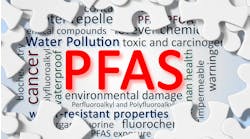Many processing plants need good quality water to feed the steam boilers and heat recovery coils of process heaters. Some plants also may require good quality water for their process. Most plants obtain fresh water either from the city utility water supply or by pumping from ground wells. However, fresh water from natural resources usually contains dissolved minerals. Some, such as calcium chlorides and sulfates and magnesium, tend to precipitate when heated and can foul the tubes in steam and waste heat boilers. This fouling not only reduces heat transfer efficiency but also can lead to overheating and tube leaks, forcing unplanned boiler shutdowns. Hence, removal of these minerals is essential for efficient boiler and heater operation.
[pullquote]
Water softeners convert the fouling characteristics of dissolved minerals but don't remove the minerals from the water. Maintaining the allowable concentration of dissolved solids requires continually draining a pre-set quantity of water, commonly referred as blowdown, from the boiler. When the quantity or pressure of steam generation is high, blowdown increases, resulting in higher energy losses. Improving the feed water quality with techniques that minimize the dissolved solids in water would reduce the blowdown, improve the heat transfer efficiency and increase the heat recovery equipment's run-length as well.
As an example, a petroleum refinery located in Salt Lake City, Utah, that processes 25,000 barrels per day of crude oil in 1998 replaced its hot lime softener that required frequent blowdown with a reverse osmosis (RO) unit to improve boiler feed-water quality. This swap is applicable to many other chemical processing plants as well.
Reverse osmosis essentially is a filtration process at the molecular level. Incoming fresh water is first filtered through several layers of progressively finer and denser material to remove the suspended matter before the water is passed to the RO unit. The water is forced at high pressures through a semi-permeable membrane that slows the passage of the dissolved solids. The RO unit is a stack of RO tubes arranged for parallel flow. Each RO tube has a concentric inner tube made of a multiple-layer semi-permeable membrane. Chemicals are added to the fresh water to minimize the scaling of silica in the membranes of RO tubes and to destroy any free chlorine, which can damage the membranes. The water pressure is increased to approximately 300 psig before entering the RO unit. The water containing the dissolved solids leaves the unit and is used for either washing or discarded. The clean water product then is sent through zeolite softeners for final polishing before going to the deaerator and the boilers.
The reported total project implementation cost was $350,000. As envisioned, the most significant benefit of the project was improvement in boiler feed-water cycles — to 65 cycles from 7.5. This corresponds to a reduction in boiler blowdown from 13.3% to 1.5%. At 2001 energy prices, the calculated fuel cost savings was $165,000 per year. Other savings included boiler treatment chemicals ($36,000 per year), maintenance ($20,000 per year) and waste disposal ($4,300 per year). Additional costs include the cleaning of the RO membranes every six months, periodic replacement of the membranes, and electric power for the reverse osmosis unit pumps. The overall project evaluation reported a total net savings of approximately $200,000 per year and improved reliability of the water treatment plant.
At small- and medium-sized U.S. plants, water softening is the most common feed-water treatment technique and 10–12% is the normal level of boiler blowdown (8–10 feed-water cycles). Improving the feed water quality with RO plants would definitely bring positive results both in energy savings and in treatment chemicals' use. In places, where RO reject water could be used for washing purposes, or for cooling tower makeup, the waste water disposal quantity also could be reduced.
Reference: Project Fact sheet, Office of Industrial Technologies, Energy Efficiency, U.S. Dept. of Energy.



